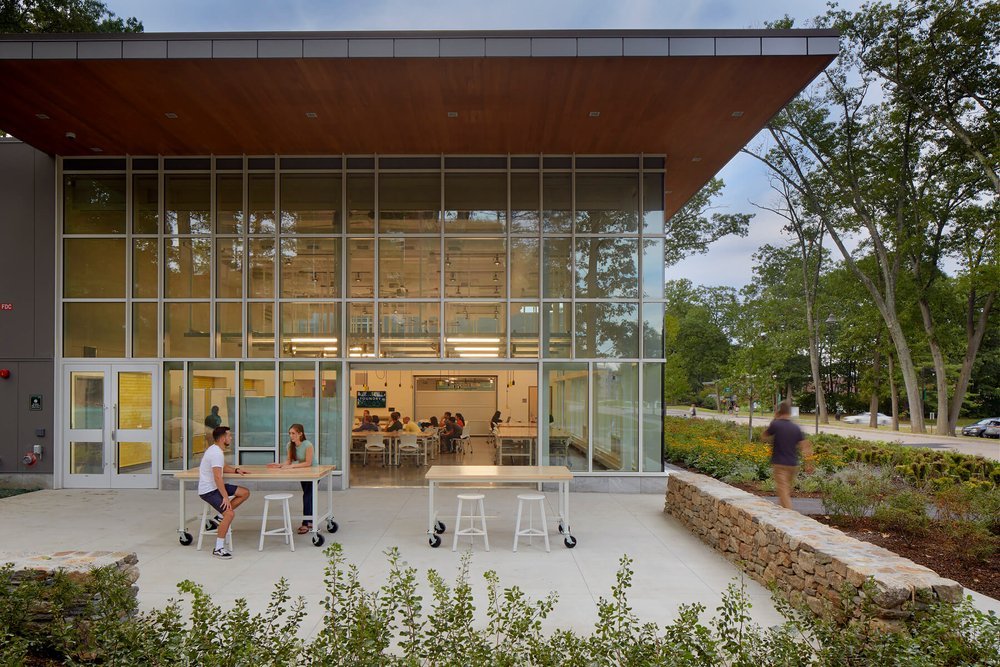
ChallengeJanos, as the Weissman Foundry's inaugural director, built its infrastructure from scratch and created a safe, collaborative space for interdisciplinary innovation among Babson, Olin, and Wellesley students.
Janos was hired as the inaugural director of the Weissman Foundry and found that it was a blank slate—a 10,000-square-foot building filled only with tables and chairs. His core challenge was twofold: establishing a comprehensive physical and digital infrastructure from scratch and creating an environment that would foster interdisciplinary, collaborative innovation among students from Babson, Olin, and Wellesley (BOW) colleges. Additionally, the Weissman Foundry needed to ensure that it met the diverse skill levels of BOW students, ranging from novice to expert prototypers, while maintaining physical, cognitive, and emotional safety for all stakeholders.
ProcessThe Weissman Foundry's launch included sourcing $250,000 in fabrication equipment, designing inclusive safety protocols, and establishing a Scout program to empower student leadership and foster interdisciplinary collaboration. To ensure sustainability, Janos also envisioned an Industry Partnership Program, connecting BOW students with companies for innovative projects and funding.
The initial stage of the Weissman Foundry’s development involved sourcing and installing over $250,000 in digital fabrication equipment. As a new space, every aspect of its physical infrastructure had to be developed, and metal and physical safety protocols were explicitly designed to accommodate the diverse user base. These protocols ensured that every user could safely operate equipment regardless of skill level.
In parallel, Janos envisioned the ‘Scout program’ to foster a culture of collaboration and innovation. Scouts were student workers trained in technical and leadership skills to act as ambassadors between the Weissman Foundry and the BOW colleges. The Scouts were given deep access and creative control over the operations and intuitions in the Weissman Foundry. This power was crucial in creating authentic ownership that would lead to community-driven events, social spaces, and mentorship programs that would form the Weissman Foundry’s unique student-centric interdisciplinary environment.
Janos also saw how an Industry Partnership Program could be developed to sustain the Weissman Foundry financially. This program would involve creating tailored corporate partnerships where companies engage with BOW students through creative sprints and semester-long projects, providing valuable industry insights and revenue for the Weissman Foundry.
SolutionThe Weissman Foundry fostered creativity and inclusivity through its 4th Culture, Scout program, and DEI initiatives, while its Corporate Partnership Program ensured financial sustainability, covering up to 90% of costs by year three.
The Weissman Foundry successfully created a dynamic, transdisciplinary space that integrated physical, cognitive, and emotional safety into its core values. The Weissman Foundry’s design-to-prototype model, supported by its unique 4th Culture, empowered students to explore ideas from diverse disciplines, resulting in increased creativity and innovation. By focusing on emotional and cognitive safety, the Weissman Foundry built a culture where all members were comfortable taking risks and sharing ideas, regardless of their personal and academic backgrounds.
The Scout program became a cornerstone of this culture. Through leadership, mentorship, and peer support, the Scouts fostered a sense of belonging and collaboration. The introduction of DEI and Bias awareness training further solidified the Foundry as a safe and inclusive space for all stakeholders. As a result, the Foundry became a thriving community that attracted students and external partners alike. The Scouts were so successful in blending the cultures of the original three college communities that they quickly created what came to be known as the 4th culture—a unique Weissman Foundry culture with roots in the three original college cultures, which then flowed upstream and began to influence the parent cultures themselves.
On the financial front, the Foundry’s Corporate Partnership Program rapidly gained traction, funding 10% of the Foundry’s operational budget within 18 months. By year three, the program was projected to cover 80-90% of the Foundry’s operational costs.
learningsThe Weissman Foundry highlighted the value of integrating safety, fostering student leadership through the Scout program, and building external partnerships. A safe, inclusive culture unlocked creativity, student-led mentorship ensured collaboration, and corporate partnerships provided financial sustainability and real-world experiences.
One of the key takeaways from the Weissman Foundry’s development was the importance of integrating safety—physical, cognitive, and emotional—into the ethos and physicality of the space. Creating a culture where all members are safe and supported is crucial for the open, honest engagement that unlocks the uniqueness of youthful creativity and innovation. The data showed that the safer the culture, the more creative and productive the community became.
The Scout program's success demonstrated student leadership's power in shaping a community. Empowering students to take on mentorship and leadership roles ensured that the Foundry remained grounded in the values of inclusivity and collaboration while also providing the practical guidance needed for creative and technical success.
Finally, the development of the Corporate Partnership Program underscored the importance of building strong external relationships. By aligning the Foundry’s capabilities with corporate partners' needs, the program provided financial support and offered valuable real-world experiences for students. The Foundry’s ability to attract and sustain these partnerships demonstrated the effectiveness of its unique approach to interdisciplinary collaboration and problem-solving.